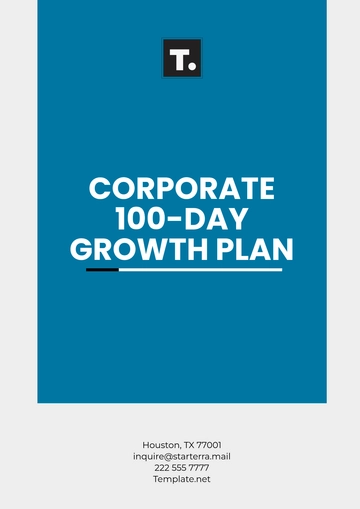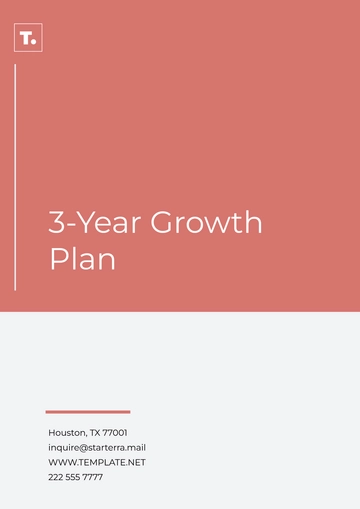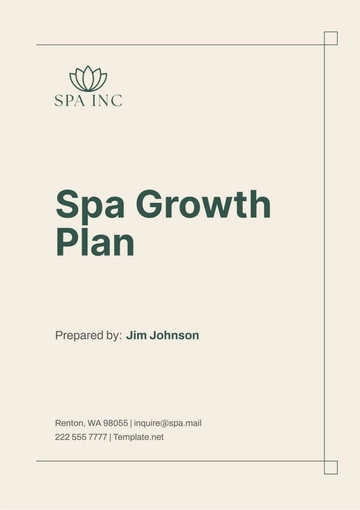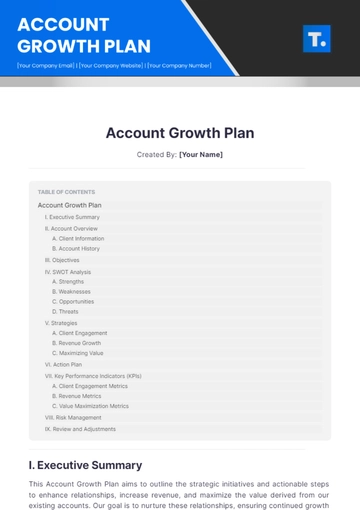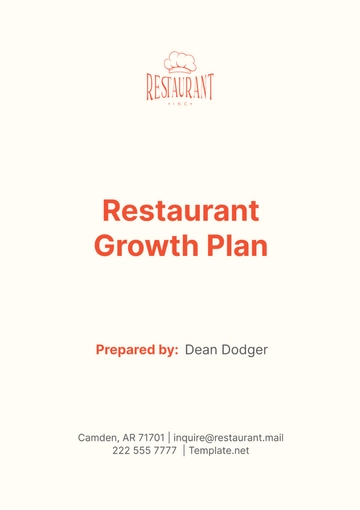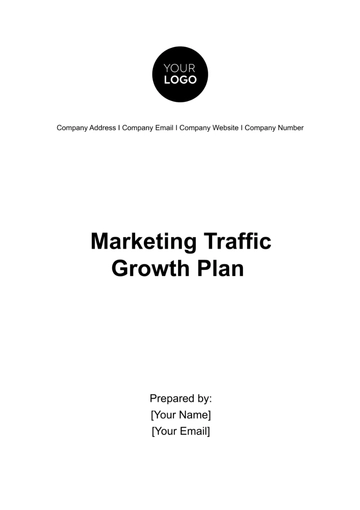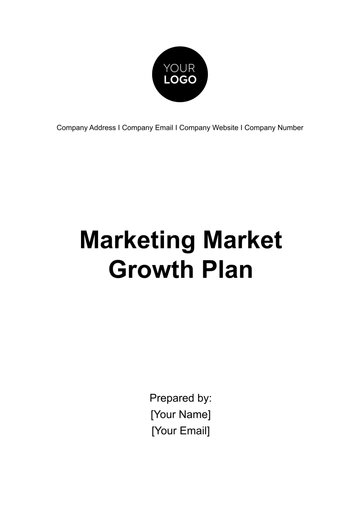Free Spa Growth Plan
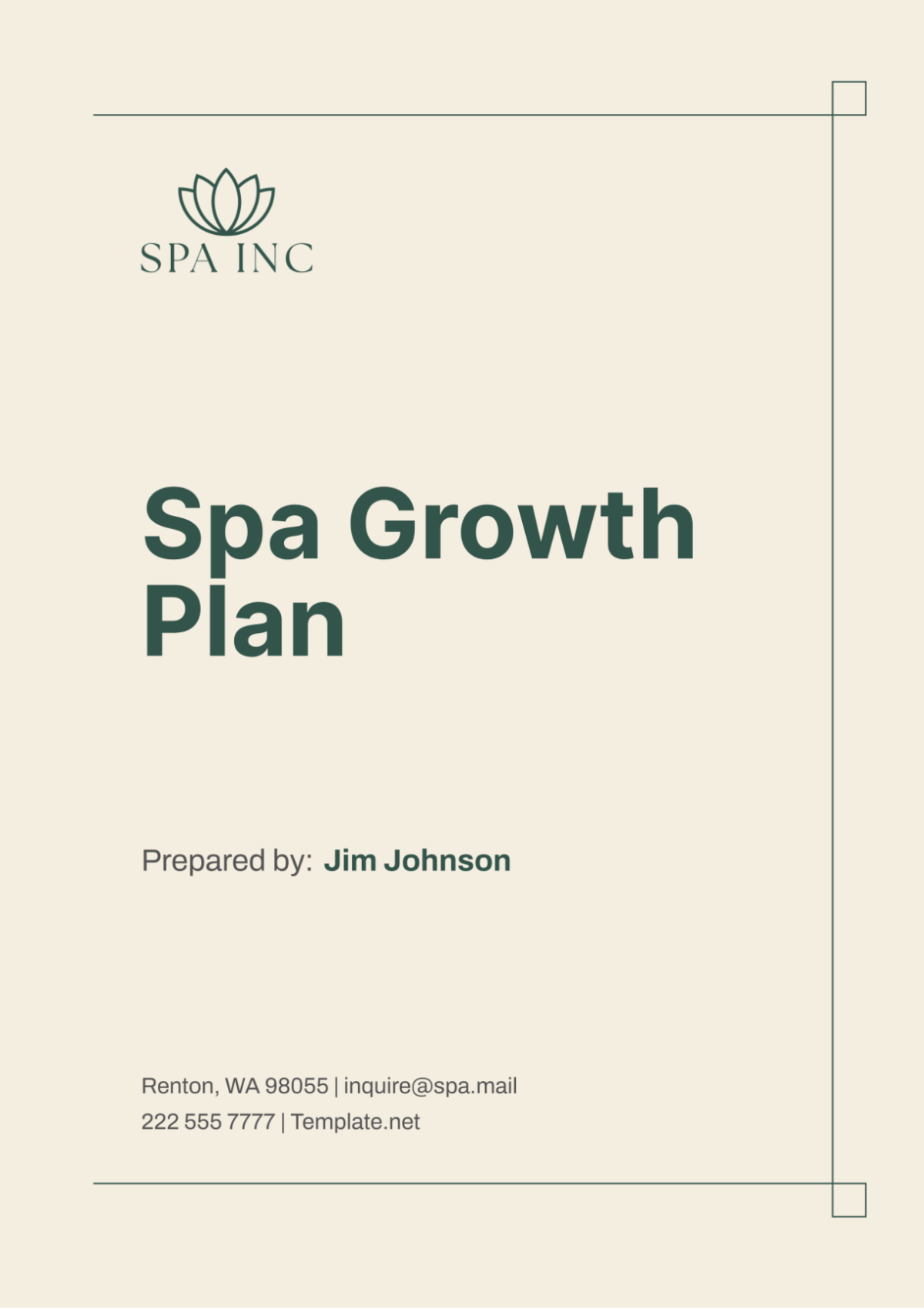
I. Executive Summary
A. Overview of the Growth Plan
The Spa Growth Plan for [Your Company Name] is designed to outline the strategic path for the company's expansion over the next five years. This plan details the steps necessary to achieve significant market penetration, enhance service offerings, and improve overall financial performance. Our goal is to establish [Your Company Name] as a premier spa destination recognized for exceptional quality and innovative wellness solutions.
B. Mission and Vision
Our mission is to provide a sanctuary where clients can rejuvenate their bodies, minds, and spirits through luxurious spa services and holistic wellness programs. Our vision is to become the leading spa brand in the region, known for our commitment to excellence, customer satisfaction, and continuous innovation.
C. Objectives and Goals
The primary objectives of this growth plan are:
To increase market share by 20% within the next three years.
To introduce five new high-demand services annually.
To achieve a customer satisfaction rate of 95%.
To expand our physical presence by opening two new locations within five years.
To enhance employee training and development programs to ensure service excellence.
II. Market Analysis
A. Industry Overview
The spa and wellness industry is experiencing robust growth globally, driven by increasing consumer awareness of health and well-being. The industry is expected to continue its upward trajectory, with annual growth rates projected at 7-10% over the next five years. Key trends include a rise in demand for personalized wellness experiences, technological integration in spa services, and the growing popularity of holistic health treatments.
B. Market Trends
Current market trends indicate a shift towards holistic wellness, encompassing not only traditional spa services but also alternative therapies such as acupuncture, aromatherapy, and mindfulness practices. There is also a significant increase in demand for eco-friendly and sustainable spa practices.
C. Target Market Segmentation
Our target market consists of the following segments:
Affluent Professionals: Individuals seeking luxury and relaxation services.
Health Enthusiasts: Clients interested in holistic and wellness-oriented treatments.
Corporate Clients: Businesses looking for wellness programs for their employees.
Tourists: Visitors seeking local, high-quality spa experiences.
D. Competitive Analysis
[Your Company Name] faces competition from both local and national spa chains. Key competitors include:
Local Spas: Offer personalized services but may lack comprehensive wellness programs.
National Chains: Provide consistent quality but often lack the personal touch and customization.
E. SWOT Analysis
Strengths | Weaknesses |
|---|---|
Strong brand reputation | Limited physical presence |
High-quality, personalized services | High operational costs |
Skilled and certified staff | Dependence on local clientele |
Opportunities | Threats |
|---|---|
Expansion into new markets | Intense competition |
Introduction of innovative wellness programs | Economic downturn affecting discretionary spending |
Strategic partnerships with health providers | Regulatory changes affecting operations |
III. Strategic Goals and Objectives
A. Short-term Goals
In the next 12 months, we aim to:
Increase our marketing efforts to raise brand awareness by 15%.
Launch three new wellness services.
Improve customer retention rates by 10%.
Enhance the training programs for our staff to ensure consistent service quality.
B. Long-term Goals
Over the next five years, our objectives are to:
Double our revenue through strategic expansion and service diversification.
Establish [Your Company Name] as a leader in sustainable and eco-friendly spa practices.
Expand our market presence by opening two additional spa locations.
Develop and implement a comprehensive employee development program.
C. Key Performance Indicators (KPIs)
To measure our progress, we will track the following KPIs:
Revenue growth rate
Customer satisfaction scores
Employee retention rates
Number of new services launched
Market share percentage
IV. Marketing and Sales Strategies
A. Brand Positioning
[Your Company Name] will position itself as a luxury spa offering personalized and innovative wellness solutions. Our brand will emphasize quality, exclusivity, and a holistic approach to health and well-being.
B. Marketing Channels and Tactics
We will utilize a mix of traditional and digital marketing channels, including:
Social Media Marketing: Engage with customers through platforms like Instagram, Facebook, and Pinterest.
Content Marketing: Provide valuable wellness content through blogs, newsletters, and videos.
Partnerships and Collaborations: Collaborate with local businesses, hotels, and health organizations to reach new customers.
C. Digital Marketing Strategy
Our digital marketing efforts will focus on:
Search Engine Optimization (SEO): Improve our website's visibility on search engines.
Pay-Per-Click Advertising (PPC): Use targeted ads to attract potential clients.
Email Marketing: Build a strong email list to share promotions and wellness tips.
D. Sales Strategy
Our sales strategy includes:
Upselling and Cross-Selling: Train staff to recommend additional services and products.
Membership Programs: Offer membership packages with exclusive benefits to encourage repeat business.
Referral Programs: Implement a referral program to incentivize existing clients to bring new customers.
E. Customer Retention and Loyalty Programs
To enhance customer retention, we will:
Loyalty Programs: Develop a loyalty rewards program to recognize and reward frequent customers.
Feedback Systems: Implement robust feedback mechanisms to continuously improve services based on customer input.
V. Service Expansion and Development
A. New Services Introduction
We plan to introduce innovative services such as:
Therapeutic Yoga Sessions: Integrate yoga therapy to promote physical and mental well-being.
Advanced Skincare Treatments: Offer cutting-edge skincare solutions using the latest technology.
Holistic Health Consultations: Provide personalized health and wellness consultations.
B. Service Improvement Initiatives
Continuous improvement will be achieved by:
Regularly updating service menus based on customer feedback and industry trends.
Investing in staff training and development to enhance service delivery.
Incorporating the latest technologies and techniques in spa treatments.
C. Customer Experience Enhancement
We will enhance the customer experience by:
Creating a serene and luxurious spa environment.
Offering personalized services tailored to individual needs.
Ensuring consistent and exceptional service quality.
D. Spa Environment and Ambiance Upgrades
To create a relaxing and welcoming atmosphere, we will:
Renovate and update the spa interiors with modern, eco-friendly materials.
Implement ambient lighting and soothing music to enhance the relaxation experience.
Incorporate elements of nature, such as indoor plants and water features, to create a tranquil environment.
VI. Financial Plan
A. Revenue Projections
We project a steady increase in revenue, with a growth rate of 15% annually. This will be achieved through the introduction of new services, increased marketing efforts, and strategic expansion.
Year | Revenue Target | Growth Rate |
|---|---|---|
$1,200,000 | 15% | |
$1,380,000 | 15% | |
$1,587,000 | 15% | |
$1,825,050 | 15% | |
$2,098,807.50 | 15% |
B. Expense Budgeting
We will maintain a detailed budget to control costs and ensure financial stability. Major expense categories include:
Staff Salaries and Benefits
Marketing and Advertising
Operational Costs
Facility Maintenance and Upgrades
C. Profit and Loss Forecast
Our profit and loss forecast is as follows:
Year | Revenue | Expenses | Net Profit |
|---|---|---|---|
$1,200,000 | $900,000 | $300,000 | |
$1,380,000 | $1,000,000 | $380,000 | |
$1,587,000 | $1,100,000 | $487,000 | |
$1,825,050 | $1,200,000 | $625,050 | |
$2,098,807.50 | $1,300,000 | $798,807.50 |
D. Break-Even Analysis
We anticipate reaching the break-even point within the first 18 months of implementing the growth plan. This will be achieved through careful financial management and strategic investment in high-return areas.
E. Funding and Investment Requirements
To support our growth plan, we will seek additional funding through:
Equity Investment: Attracting investors interested in the wellness industry.
Bank Loans: Securing loans with favorable terms to finance expansion.
Internal Profits: Reinvesting profits into the business to fuel growth.
VII. Human Resources and Staffing
A. Staff Recruitment and Training
We will focus on recruiting skilled and passionate professionals who align with our mission and values. Our recruitment process will include:
Job Fairs and Recruitment Events: To attract top talent.
Online Job Portals: Posting job openings on popular job boards.
Employee Referrals: Encouraging current employees to refer qualified candidates.
Training programs will be designed to ensure all staff members are well-versed in the latest spa techniques and customer service standards. Continuous education opportunities will be provided to keep staff updated on industry trends and advancements.
B. Employee Development Programs
To retain and develop our employees, we will implement:
Professional Development Workshops: Covering topics such as advanced spa techniques, customer service excellence, and wellness trends.
Mentorship Programs: Pairing new employees with experienced staff for guidance and support.
Performance-Based Incentives: Rewarding employees for exceptional performance and dedication.
C. Organizational Structure
Our organizational structure will be designed to support growth and operational efficiency. Key roles will include:
Spa Manager: Overseeing daily operations and ensuring service quality.
Marketing Director: Developing and executing marketing strategies.
HR Manager: Managing recruitment, training, and employee relations.
Service Coordinators: Ensuring smooth delivery of spa services and managing client bookings.
D. Performance Evaluation and Incentives
Regular performance evaluations will be conducted to assess employee performance and identify areas for improvement. Incentives will be offered to motivate and reward employees, including:
Bonuses: Based on performance metrics and customer feedback.
Recognition Programs: Acknowledging outstanding contributions through awards and certificates.
Career Advancement Opportunities: Providing pathways for career growth within the company.
VIII. Operational Plan
A. Daily Operations Management
To ensure smooth and efficient daily operations at [Your Company Name], we will implement standardized procedures for all aspects of our spa services. This includes appointment scheduling, customer service protocols, and inventory management.
B. Appointment Scheduling
We will use a state-of-the-art appointment scheduling software to manage bookings, minimize wait times, and optimize staff allocation. This software will allow clients to book appointments online, receive automated reminders, and provide feedback after their visits.
C. Customer Service Protocols
Customer service excellence will be a core focus. Staff will be trained to greet clients warmly, offer personalized service recommendations, and handle any issues with professionalism and empathy. Regular customer service training sessions will ensure that all staff members adhere to our high standards.
D. Inventory Management
Effective inventory management is critical for maintaining operational efficiency and minimizing costs. We will implement an inventory management system that tracks stock levels, forecasts demand, and automates reordering processes. This system will help ensure that we always have the necessary supplies on hand without overstocking.
Task | Frequency | Responsible Party | Notes |
|---|---|---|---|
Appointment Scheduling | Daily | Front Desk Staff | Use scheduling software |
Customer Service | Daily | All Staff | Follow service protocols |
Inventory Check | Weekly | Inventory Manager | Update stock levels |
Reordering Supplies | Monthly | Inventory Manager | Automate reordering |
E. Technology and Systems Implementation
We will invest in the latest technology to streamline operations and enhance the customer experience. This includes upgrading our booking system, implementing customer relationship management (CRM) software, and using data analytics to gain insights into customer preferences and behavior.
F. Quality Control Measures
To maintain high standards, we will establish quality control measures across all services. This includes regular staff evaluations, mystery shopper programs, and customer feedback surveys. These measures will help us identify areas for improvement and ensure consistent service quality.
IX. Risk Management
A. Identifying Potential Risks
Risk management is essential for safeguarding the future of [Your Company Name]. Potential risks include economic downturns, regulatory changes, and competition from other spas. We will conduct a thorough risk assessment to identify and prioritize these risks.
B. Risk Mitigation Strategies
To mitigate identified risks, we will develop comprehensive strategies. For economic downturns, we will focus on cost control and diversifying our revenue streams. To address regulatory changes, we will stay informed about industry regulations and ensure compliance. To manage competition, we will continuously innovate and differentiate our services.
Risk | Mitigation Strategy | Responsible Party |
|---|---|---|
Economic Downturn | Focus on cost control, diversify revenue | Financial Manager |
Regulatory Changes | Stay informed, ensure compliance | Compliance Officer |
Increased Competition | Innovate, differentiate services | Marketing Director |
C. Crisis Management Plan
A crisis management plan will be in place to handle unexpected events, such as natural disasters or significant service disruptions. This plan will outline the steps to take in various scenarios, designate roles and responsibilities, and provide communication protocols to ensure swift and effective response.
X. Implementation Timeline
A. Phased Implementation Plan
The implementation of our growth plan will be executed in phases to ensure manageable progress and allow for adjustments as needed. Each phase will focus on specific areas of growth, from market expansion to service innovation.
Phase | Timeline | Key Activities |
|---|---|---|
Phase 1: Foundation | Months 1-6 | Staff training, system upgrades |
Phase 2: Expansion | Months 7-18 | Launch new services, open new location |
Phase 3: Enhancement | Months 19-36 | Customer experience improvement |
Phase 4: Consolidation | Months 37-60 | Evaluate progress, make adjustments |
B. Key Milestones and Deadlines
Key milestones will be established to track progress and ensure timely completion of activities. Regular review meetings will be held to assess progress against milestones and address any challenges.
Milestone | Deadline | Responsible Party |
|---|---|---|
Staff Training Completion | Month 3 | HR Manager |
New Service Launch | Month 9 | Service Director |
New Location Opening | Month 18 | Operations Manager |
Customer Satisfaction Goal | Month 24 | Marketing Director |
C. Responsibility Assignments
Clear responsibility assignments will ensure accountability and efficient execution of the growth plan. Each key activity will be assigned to a specific team or individual, with defined roles and expectations.
XI. Monitoring and Evaluation
A. Performance Tracking
Performance tracking is crucial for assessing the effectiveness of our growth strategies. We will use KPIs to measure progress in key areas such as revenue growth, customer satisfaction, and employee performance.
B. Regular Review Meetings
Regular review meetings will be scheduled to evaluate progress and discuss any issues or opportunities. These meetings will involve key stakeholders and provide a forum for collaborative problem-solving and decision-making.
Meeting Type | Frequency | Attendees | Agenda |
|---|---|---|---|
Executive Review | Monthly | Senior Management Team | Review KPIs, address challenges |
Departmental Check-in | Bi-weekly | Department Heads | Monitor progress, discuss updates |
Staff Feedback | Quarterly | All Staff | Gather feedback, suggest improvements |
C. Feedback Mechanisms
We will implement robust feedback mechanisms to gather input from clients and employees. This includes regular surveys, suggestion boxes, and open forums. Feedback will be analyzed and used to make continuous improvements.
D. Adjustments and Continuous Improvement
Based on performance tracking and feedback, we will make necessary adjustments to our strategies. Continuous improvement will be a key focus, ensuring that we remain adaptable and responsive to changing market conditions and customer needs.
XII. Conclusion
A. Recap of Growth Plan
The Spa Growth Plan for [Your Company Name] outlines a comprehensive strategy for achieving significant growth and establishing our brand as a leader in the spa and wellness industry. Through careful planning, strategic investments, and a commitment to excellence, we aim to enhance our service offerings, expand our market presence, and ensure long-term financial success.
B. Final Thoughts and Future Outlook
Our vision for the future is bright. With a clear growth plan in place, we are confident in our ability to navigate the challenges ahead and capitalize on new opportunities. By staying true to our mission and values, continuously innovating, and prioritizing customer satisfaction, [Your Company Name] will continue to thrive and set new standards in the spa and wellness industry.
- 100% Customizable, free editor
- Access 1 Million+ Templates, photo’s & graphics
- Download or share as a template
- Click and replace photos, graphics, text, backgrounds
- Resize, crop, AI write & more
- Access advanced editor
Plan strategically with Template.net's Spa Growth Plan Template. This customizable and editable template, accessible via the Ai Editor Tool, helps you draft comprehensive growth plans. Personalize it to include specific goals and strategies. Ensure clear and organized documentation to support successful business expansion and growth in your spa.
You may also like
- Finance Plan
- Construction Plan
- Sales Plan
- Development Plan
- Career Plan
- Budget Plan
- HR Plan
- Education Plan
- Transition Plan
- Work Plan
- Training Plan
- Communication Plan
- Operation Plan
- Health And Safety Plan
- Strategy Plan
- Professional Development Plan
- Advertising Plan
- Risk Management Plan
- Restaurant Plan
- School Plan
- Nursing Home Patient Care Plan
- Nursing Care Plan
- Plan Event
- Startup Plan
- Social Media Plan
- Staffing Plan
- Annual Plan
- Content Plan
- Payment Plan
- Implementation Plan
- Hotel Plan
- Workout Plan
- Accounting Plan
- Campaign Plan
- Essay Plan
- 30 60 90 Day Plan
- Research Plan
- Recruitment Plan
- 90 Day Plan
- Quarterly Plan
- Emergency Plan
- 5 Year Plan
- Gym Plan
- Personal Plan
- IT and Software Plan
- Treatment Plan
- Real Estate Plan
- Law Firm Plan
- Healthcare Plan
- Improvement Plan
- Media Plan
- 5 Year Business Plan
- Learning Plan
- Marketing Campaign Plan
- Travel Agency Plan
- Cleaning Services Plan
- Interior Design Plan
- Performance Plan
- PR Plan
- Birth Plan
- Life Plan
- SEO Plan
- Disaster Recovery Plan
- Continuity Plan
- Launch Plan
- Legal Plan
- Behavior Plan
- Performance Improvement Plan
- Salon Plan
- Security Plan
- Security Management Plan
- Employee Development Plan
- Quality Plan
- Service Improvement Plan
- Growth Plan
- Incident Response Plan
- Basketball Plan
- Emergency Action Plan
- Product Launch Plan
- Spa Plan
- Employee Training Plan
- Data Analysis Plan
- Employee Action Plan
- Territory Plan
- Audit Plan
- Classroom Plan
- Activity Plan
- Parenting Plan
- Care Plan
- Project Execution Plan
- Exercise Plan
- Internship Plan
- Software Development Plan
- Continuous Improvement Plan
- Leave Plan
- 90 Day Sales Plan
- Advertising Agency Plan
- Employee Transition Plan
- Smart Action Plan
- Workplace Safety Plan
- Behavior Change Plan
- Contingency Plan
- Continuity of Operations Plan
- Health Plan
- Quality Control Plan
- Self Plan
- Sports Development Plan
- Change Management Plan
- Ecommerce Plan
- Personal Financial Plan
- Process Improvement Plan
- 30-60-90 Day Sales Plan
- Crisis Management Plan
- Engagement Plan
- Execution Plan
- Pandemic Plan
- Quality Assurance Plan
- Service Continuity Plan
- Agile Project Plan
- Fundraising Plan
- Job Transition Plan
- Asset Maintenance Plan
- Maintenance Plan
- Software Test Plan
- Staff Training and Development Plan
- 3 Year Plan
- Brand Activation Plan
- Release Plan
- Resource Plan
- Risk Mitigation Plan
- Teacher Plan
- 30 60 90 Day Plan for New Manager
- Food Safety Plan
- Food Truck Plan
- Hiring Plan
- Quality Management Plan
- Wellness Plan
- Behavior Intervention Plan
- Bonus Plan
- Investment Plan
- Maternity Leave Plan
- Pandemic Response Plan
- Succession Planning
- Coaching Plan
- Configuration Management Plan
- Remote Work Plan
- Self Care Plan
- Teaching Plan
- 100-Day Plan
- HACCP Plan
- Student Plan
- Sustainability Plan
- 30 60 90 Day Plan for Interview
- Access Plan
- Site Specific Safety Plan
